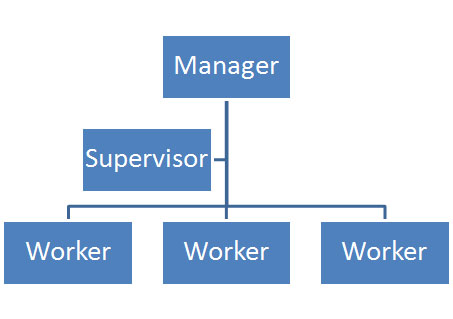Horizontal Leadership
Flattening the Organization
Vertical leadership may be defined as an organization where leaders are in a formal position of power at the top of the hierarchy and whose commands typically run down the hierarchy, while information flows up it.
However, if we view leadership as being a total system, rather than lying in individual power, then we have horizontal or flat leadership that may be defined as a network of people where commands and information flow in all directions.
Vertical Leadership vs. Horizontal Leadership:
 |
 |
|---|
Two Case Studies on Vertical Leadership vs. Horizontal Leadership

David Talbot (2004) published an interesting story in MIT Technology Review about a fairly conventional fight between the U.S. Army's 69th Armor Regiment and Saddam's Army near a key bridge on the Euphrates River in 2003.
The Iraqi attack force was quite large; thus it should have been known well in advance since the U.S. troops were supported by a large technology-assisted intelligence network, such as aircraft spotters, satellite-mounted motion sensors, heat detectors, image sensors, and communications eavesdroppers. Commanders had high-bandwidth links to tap into this intelligence network while in the field. Yet, during the battle, Lt. Col. Marcone, the U.S. Army battalion commander on the scene, was starved for information about Iraqi troop movements.
As night fell, Marcone realized the situation was getting quite threatening — his force of 1,000 soldiers were facing about 7,000 Iraqi soldiers coming at him from three directions.
This Iraqi deployment should have been fairly easy to detect, yet they received no information until the Iraqis slammed into them. This was not an isolated case as one key node was consistently falling off the intelligence network — the front-line troops. This soon became known as the digital divide — at the division level and above, the view of the battle space was adequate, yet among the front-line troops, such as Marcone's, the situational awareness was terrible.
Lucky for Marcone, the tactical adroitness of his warriors easily overcame the attacking Iraqi army — they won on superior tactical strength, rather than a vision of total knowledge. The communication breakdown was out of date as it used vertical command and control, rather than a horizontal flow. Information was to go up the chain of command so that the major commanders in the rear could interpret it, and then send down their decisions. This resulted in major time delays. Thus, the information was out there, yet it was not getting to the people in time who needed it the most.
In contrast, during the war in Afghanistan, special-operations forces were organized into small teams, composed of about two dozen soldiers, who patrolled the mountains near the Pakistan border on horseback. Their mission was to root out the Taliban and al-Qaeda forces. Rather than being linked to a central command, the teams were networked to each other — no one person was in tactical command.
Each team also had a key node — the alpha geek, whose job was to manage the flow of information between his team and the others'. Thus, rather than being confined to the “corporate IT department,” the information geeks were actually in the field.
These special force units maintained a web page who arranged all the data collected by the teams into information that could easily be accessed by all.
The Afghanistan special-operations forces was a flat Army using horizontal leadership to let the information flow as a network, unlike the American forces in Iraq whose vertical leadership controlled the information. From this point-of-view, the horizontal teams received leadership contributions from every member, not just the official designated leader found in vertical organizations.
Horizontal Leadership is a Perfect Fit for OODA
One of the advantages of horizontal leadership is that it is shaped to fit with the OODA Loop model of Observe, Orient, Decide, and Act. Thus, it allows for a faster decision making process. The below diagram shows how convoluted the communication process is in a vertical organization:

On the other hand, communications that include information and decision-making in a horizontal organization work much faster and smoothly for all the individuals and teams in the organization:

Horizontal leadership is a means of involving networked teams to ensure the organization's vision is executed.
Next Steps
Use the Horizontal Leadership Instrument to assess your team's Horizontal Leadership capability.
Next chapter: The Four Pillars: Leadership, Management, Command, and Control
Reference
Talbot, D. (2004). How Technology Failed in Iraq. MIT Technology Review. Retrieved from http://www.technologyreview.com/featuredstory/403319/how-technology-failed-in-iraq/
